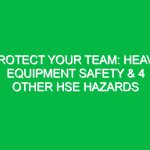Introduction
In the realm of Health, Safety, and Environment (HSE), the concept of the hierarchy of controls serves as a foundational framework for managing risks and ensuring the safety of workers and the environment. Defined as a systematic approach to mitigating hazards, this hierarchy allows organizations to prioritize control measures based on their effectiveness. By understanding and implementing the hierarchy of controls, companies can significantly reduce the potential for accidents and injuries, fostering a culture of safety that benefits everyone involved.
This article will delve deep into the hierarchy of controls, exploring its key components, practical applications, and the regulations that shape its implementation in the HSE context. Through real-life examples and actionable insights, we aim to equip readers with the necessary knowledge to apply these strategies effectively.
Understanding the Hierarchy of Controls
The hierarchy of controls is typically represented as a pyramid, with the most effective control measures at the top and the least effective at the bottom. The main categories, in descending order of effectiveness, are as follows:
- Elimination
- Substitution
- Engineering Controls
- Administrative Controls
- Personal Protective Equipment (PPE)
Each of these levels plays a critical role in managing workplace hazards, and understanding their application is essential for any HSE professional.
1. Elimination
The most effective control measure is elimination, which involves completely removing the hazard from the workplace. For example, if a company identifies that a particular chemical is harmful, the best course of action would be to discontinue its use altogether. This not only protects workers but also eliminates the possibility of accidental exposure or environmental contamination.
A real-life example of successful elimination is seen in the construction industry. Companies may opt to use construction methods that do not require scaffolding, thereby removing the associated fall hazards entirely.
2. Substitution
When elimination is not feasible, the next step is substitution. This involves replacing a hazardous material or process with a less dangerous alternative. For instance, a manufacturing facility might replace a solvent with a water-based product that poses less risk to health and the environment.
Such substitutions not only enhance safety but can also lead to cost savings in the long run. An illustrative example can be found in the automotive industry, where manufacturers have successfully replaced lead-based paints with safer alternatives, reducing health risks for workers and compliance costs related to hazardous material handling.
3. Engineering Controls
If elimination or substitution is impractical, engineering controls should be implemented. These controls involve redesigning equipment or processes to minimize exposure to hazards. Common engineering controls include ventilation systems, machine guards, and soundproofing.
For example, a factory might install a local exhaust ventilation system to capture harmful fumes at the source, thus reducing the risk of respiratory issues among workers. This approach not only protects employees but also contributes to a healthier workplace environment.
4. Administrative Controls
Administrative controls involve changing the way work is performed to reduce exposure to hazards. This can include implementing policies, procedures, and training programs. For instance, rotating workers between different tasks can minimize prolonged exposure to harmful substances.
A case study highlighting the effectiveness of administrative controls is seen in healthcare settings, where shift rotations and strict protocols are established to limit staff exposure to infectious diseases. By managing work schedules and providing comprehensive training, healthcare facilities can safeguard their employees while ensuring patient care remains uncompromised.
5. Personal Protective Equipment (PPE)
Personal protective equipment is the last line of defense in the hierarchy of controls. While PPE is essential for protecting workers, it is also the least effective measure if used in isolation. PPE includes items such as helmets, gloves, masks, and goggles, and should always be used in conjunction with other control measures.
For instance, in a construction site where falling objects are a risk, workers should wear hard hats in addition to implementing engineering controls like overhead protection. This combined approach ensures maximum safety.
Implementing the Hierarchy of Controls
Successfully applying the hierarchy of controls within an organization requires a systematic approach. Here are several key steps to consider:
1. Hazard Identification
The first step in implementing the hierarchy of controls is conducting a thorough hazard assessment. This involves identifying potential hazards in the workplace, assessing their risks, and determining who may be harmed and how.
Utilizing tools such as job safety analyses or workplace inspections can facilitate this process, enabling organizations to pinpoint areas that require intervention.
2. Risk Assessment
Once hazards are identified, the next step is to evaluate the risks associated with each hazard. This involves determining the likelihood of an incident occurring and the potential severity of its consequences.
Organizations can use qualitative or quantitative risk assessment methods to prioritize hazards based on their risk levels, helping to focus resources on the most critical areas.
3. Implementing Controls
With a clear understanding of the hazards and associated risks, organizations can begin implementing controls based on the hierarchy. It is vital to involve employees in this process, as they can provide valuable insights into the effectiveness of proposed measures and contribute to a culture of safety.
4. Monitoring and Review
After implementing controls, organizations must continuously monitor their effectiveness and make adjustments as necessary. Regular reviews, audits, and feedback from employees can help identify any shortcomings in the control measures and provide opportunities for improvement.
Benefits of the Hierarchy of Controls
Implementing the hierarchy of controls offers numerous benefits for organizations, including:
- Enhanced Safety: By systematically addressing hazards, organizations can significantly reduce the risk of accidents and injuries.
- Regulatory Compliance: Adhering to the hierarchy of controls helps ensure compliance with health and safety regulations, mitigating the risk of fines or legal issues.
- Cultural Shift: Promoting a proactive safety culture encourages employees to prioritize safety and take responsibility for their own well-being and that of their colleagues.
- Cost Savings: Reducing workplace incidents can lead to lower insurance premiums, reduced absenteeism, and improved productivity.
Regulations and Standards
Understanding the regulations that govern the implementation of the hierarchy of controls is crucial for compliance. In many countries, occupational health and safety laws mandate the use of the hierarchy of controls as a framework for managing workplace hazards.
For instance, the Occupational Safety and Health Administration (OSHA) in the United States provides guidelines that emphasize the importance of the hierarchy in preventing workplace injuries. Similarly, the Health and Safety Executive (HSE) in the UK outlines the hierarchy of controls in its guidance documents, emphasizing its role in risk management and safety planning.
Organizations must stay informed about the latest regulations and standards in their industry, ensuring that their practices align with legal requirements and best practices.
Conclusion
The hierarchy of controls is a vital framework in the Health, Safety, and Environment domain, providing a systematic approach to managing workplace hazards. By prioritizing control measures and involving employees in the process, organizations can cultivate a culture of safety that protects both workers and the environment.
In summary, effective implementation of the hierarchy of controls not only enhances safety and regulatory compliance but also contributes to a more productive and responsible workplace. As we navigate an increasingly complex world, understanding and applying these principles will be essential for ensuring health, safety, and environmental sustainability for all. As HSE professionals, it is our responsibility to unlock the potential of the hierarchy of controls, driving positive change in our organizations and beyond.


